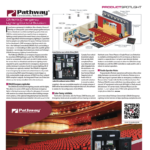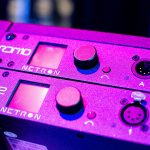One of the earliest automated lighting consoles on the market was called the Animator. It was very advanced for its time, but it never gained the widespread popularity it deserved in North America, probably because it had limited distribution. The company that designed and built that console is Compulite. For many people in the industry, Compulite is a recognizable name with recognizable products; to others it's still a bit of a mystery. The company has met with appreciable success around the world and now they are re-establishing their North American connections through the distribution of Creative Stage Lighting. Compulite is a prominent exhibitor at all the major trade shows, but in case you haven't had the opportunity to demo their latest in console products, here's a quick look at the Violet line of compact, portable consoles.
The Compulite Family
The Vector Violet and Ultra Violet consoles are part of the family of Compulite's top-of-the-line consoles that include the Vector Red, Vector Blue, Vector Green, Vector Orange, and the Vector PC. They all share the same operating system but each has a unique hardware design. Violet and Ultra Violet are both self-contained consoles (with the exception of optional extra monitors or touchscreens) that pack up like a slightly oversized laptop. But don't be fooled by their size. They are very powerful consoles that are deep in set up options, allowing you to configure the hardware to maximize its function.
The Violet has four DMX universes of output with another four universes available through the Ethernet port, and it has a DMX input to control devices on the network using another control source. It also outputs VC (Compulite native protocol), ArtNet and ACN as well as MIDI, MIDI Show Control and SMPTE time code. The VC protocol can be used to connect to visualizers, media servers, and to control Compulite devices like dimmers, ePort (Ethernet-to-DMX), and eSync (remote connection to MIDI and SMPTE). In addition to using the Ethernet port to output DMX, it can also be used to connect multiple consoles on a single network to share programming and playback duties. Up to eight consoles can be networked at a time.
Both consoles have a 7-inch TFT color touch screen to aid in programming, but in practice, it can be a bit challenging to rely on this small screen for your primary display. That's where the 15.4-inch TFT wide touchscreen built into the Ultra Violet comes in handy. This display folds down for travel and the hardshell case protects the console like a road case. It also has one external video display port to connect a second monitor or touchscreen. And although the Violet doesn't have the larger display, it does have two external video display ports, so it can be set up with just as much video real estate as the Ultra Violet.
Both the Violet and the Ultra Violet have 20 100mm playback faders, six encoder wheels, and a built-in trackball. It also has a numeric keypad and associated buttons and the command line shows up on your displays, making it easy to keep track of your keystrokes. But one of the nice things about this line of consoles is that you can use touchscreen displays and you can customize the layout of the screens. That allows you to set up your console the way you're used to programming or the way you are most comfortable. You can also set up a "topographical map" or a plan view of the fixture layout, which makes it easy to quickly select fixtures for programming or playback.
Programming Features
The consoles have many advanced programming features including an effects editor, pixel mapping ("Matrix"), macros, and more. In addition, you can integrate several visualizers including WYSIWYG, Capture, and Martin Show Designer. And of course no console would be complete these days without the ability to integrate media servers. In this case you can download and view thumbnails of media on the console display and control various media servers including Arkaos, Hippotizer, and Catalyst.
There is also a feature called Desktop that allows you to create a shortcut to almost any button on the console by dragging and dropping a soft button to the desktop view. Once the shortcut is created it can be customized by adding text, icons, or graphics. For example, you can use it to create a shortcut for a group or a preset.
One of the biggest differences between different brands of consoles is that some are tracking consoles and some are cue only, while some can be set up either way. The Vector line falls into the latter group, so if you are used to a tracking style console, they can be operated in that mode, or if you are used to a cue only console and tracking confuses you, then you have that option as well. You can also set up the consoles to set parameters using the @ key or the Enter key, whichever you are most comfortable using.
Since the consoles in the Vector line have the same operating system, they have the same programming features and syntax. Plus, they can easily be configured in master/slave mode to use as a backup tracking console. If the master console goes down, the slave automatically starts outputting the control signal, picking up where the master left off. The family of consoles also shares accessories such as programming and playback wings, and they can read and play each other's show files. Even the PC version of the Vector line uses the same operating system and it allows you to use it as an offline editor.
It used to be that lighting programmers and operators clamored for bigger consoles at FOH, partly as an ego booster and partly because having to use several layers of function keys can be a pain. But given the speed and power of today's processors, there is no reason to have to choose between power and size or between size and accessibility. The Vector consoles allow you to set up the console the way you like it so you don't have to be digging through multiple layers of functions to execute a command. It's a powerful line of consoles that are easy to learn and the two Violets harness the power in a small package. Most programmers have a strong preference for one or two models of consoles but any programmer would be well served to give the Vectors a go.
Compulite Vector Violet and Ultra Violet
What They Are: Lighting consoles for automated or conventional lights
Who They're For: Programmers looking for a range of applications from small lighting rigs to the largest of lighting rigs
Pros: Compact and portable, powerful, deep features, easy learning curve
Cons: not yet widely available in North American production companies
How Much: Ultra Violet: $19,500; Violet: $17,995.


